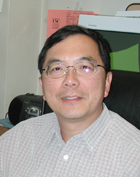 |
|
 |
|
|
CATALYST FOR HAIR FOLLICLE BIOLOGY (CHFB) - Established in December 2002, this two-year collaboration totals $230,000 in funding, and brings together two leading hair follicle biologists. The Foundation announced the researchers and the consortium in January. The members are:
This consortium funding offers the potential to build upon the results that Dr. Christiano and Dr. Colin Jahoda have achieved through their informal collaboration thus far. As a result of publicity about Dr. Jahoda's work, there have been a number of lucrative offers to market human hair loss "cures" from commercial sources. Both Drs. Jahoda and Christiano, however, believe that developing the research for therapeutic purposes should be done on an independent scientific basis. Unfortunately, given that conventional avenues of research funding consider this to be a 'cosmetic' problem, few, if any funds are available. We hope that by encouraging and supporting an effective collaboration, we will add real value to the work being conducted in these laboratories and send a positive message that can be leveraged into funding from other sources.
The CHFB consortium will apply the emerging technologies of developmental biology, stem cell biology and tissue engineering to the induction of new hair follicles. The investigators have pioneered methods for the culture of hair follicle cells, and Dr. Jahoda was the first individual to demonstrate that new hair follicles can be induced to form in adult skin by implantation of cultured cells. Up to now, work has mainly been performed in animal models, and the induction of human hair follicles poses specific challenges relating to human hair follicle biology. The major focus of the CHFB is to establish that new human hair follicles can be created from cultured cells in adult human skin using transplantation techniques. The overall goal is the unequivocal demonstration that cultured human cells can induce new follicle formation and hair growth in human skin. Ultimately the hope is that the research can be used successfully to cure such conditions as premature balding and alopecia areata and offer solutions for hair loss due to chemotherapy. The three primary strategies for the two-year research period include:
Year One Progress Report Our previous work has demonstrated that the key dermal cells from the base of the hair follicle, the dermal papilla cells are key to the creation of hair follicles and to control of hair growth in mature follicles. Another related group of cells, the dermal sheath, are an important reservoir for replacing papilla cells that are lost. In this period we have published the first description in which both of these cell types have been "cloned". This cloning, which is not to be confused with the much publicized reproductive cloning, involves isolating single cells and then growing up large populations from these lone progenitors. This is a key step in possible therapeutic developments since it potentially allows us to select specific cell populations that are able to stimulate hair follicles to form. To this end we have been analyzing the cellular and molecular properties of different clonal lines as a prelude to testing their functional capabilities. Intriguingly, we have also discovered that some papilla and sheath cells are adult stem cells in that they can be turned into other tissues such as bone and fat. Therefore the scope for practical use of such cells goes beyond skin and hair. Year Two Progress Report CHFB is a partnership aimed at applying the emerging technologies of developmental biology, stem cell biology and tissue engineering to the induction of new hair follicles. CHFB investigators have pioneered methods for the culture of hair follicle cells, and were the first to demonstrate that new hair follicles can be induced to form in adult skin by implantation of cultured cells. Up to now, work has mainly been performed in animal models, and the induction of human hair follicles poses specific challenges relating to human hair follicle biology. As a prelude to human clinical trials, the major focus of the CHFB is to establish that new human hair follicles can be created from cultured cells in adult human skin using transplantation techniques. Our overall goal is the unequivocal demonstration that cultured human cells can induce new follicle formation and hair growth in human skin. In this context we have also explored the relationship between hair follicles and other appendages and to this end we have demonstrated that tooth derived cells can induce new fiber growth in hair follicles. We performed a microarray comparison between freshly dissected DP cells from rat vibrissa compared to freshly dissected DS cells from the same animals. This highly informative microarray study has yielded much information that will provide a foundation for the analysis of induction-promoting genes. We expanded this microarray approach and have performed microdissection on several other hair follicle compartments, including germinative epithelial cells, hair matrix cells, and bulge region cells. Additionally, we have performed a detailed time-course study of microdissected dermis and epidermis during mouse embryonic development on the back skin as well as the whisker pad. This approach has been enormously fruitful and has revealed several interesting novel candidate genes involved in hair follicle induction. At the conclusion of this period of two years, the CHFB has allowed us to make significant advances toward the goal of propagation of hair follicle cells in culture and induction of new hair follicles using human cells. It is anticipated that this technology could represent a novel methodology for cell-based and tissue engineering approaches to the regeneration of new hair follicles. Publications Resulting from the CHFB Project CA Jahoda, CJ Whitehouse, AJ Reynolds, & N Hole. 2003. Hair follicle dermal cells differentiate into adipogenic and osteogenic lineages. Exp. Dermatol. 12:849-849. AM Christiano. 2004. Epithelial stem cells: stepping out of their niche. Cell. 118:530-532. AM Christiano and CA Jahoda. 2004. Special issue on epidermal and hair follicle differentiation, part 1. Differentiation. 72:363. AM Christiano and CA Jahoda. 2004. Special issue on epidermal and hair follicle differentiation, part 2. Differentiation. 72:465. I Fliniaux, JP Viallet, D Dhouailly, & CA Jahoda. 2004. Transformation of amnion epithelium into skin and hair follicles. Differentiation. 72:558-565. CA Jahoda, A Kljuic, R O’Shaughnessy, N Crossley, CJ Whitehouse, M Robinson, AJ Reynolds, M Demarchez, RM Porter, L Shapiro, & AM Christiano. 2004. The lanceolate hair rat phenotype results from a missense mutation in a calcium-coordinating site of the desmoglein 4 gene. Genomics. 83:747-756. H Kim, AA Panteleyev, CA Jahoda, Y Ishii, & AM Christiano. 2004. Genomic organization and analysis of the hairless gene in four hypotrichotic rat strains. Mamm Genome. 15:975-981. RF O’Shaughnessy and AM Christiano. 2004. Inherited disorders of the skin in human and mouse: from development to differentiation. Int J Dev Biol. 48:171-179. RF O’Shaughnessy, AM Christiano, & CA Jahoda. 2004. The role of BMP signaling in the control of ID3 expression in the hair follicle. Exp Dermatol. 13(10):621-9. RF O’Shaughnessy, W Yeo, J Gautier, CA Jahoda, & AM Christiano. 2004. The WNT signaling modulator, Wise, is expressed in an interaction-dependent manner during hair follicle cycling. J Invest Dermatol. 123(4):613-21. AJ Reynolds and CA Jahoda. 2004. Cultured human and rat tooth papilla cells induce hair follicle regeneration and fiber growth. Differentiation. 72:566-575. H Uyttendaele, AA Panteleyev, D de Berker, DT Tobin, & AM Christiano. 2004. Activation of Notch 1 in the hair follicle leads to cell-fate switch and Mohawk alopecia. Differentiation. 72:396-409. GD Richardson, EC Arnott, CJ Whitehouse, C Lawrence, AJ Reynolds, N Hole, & CAB Jahoda. In press. Plasticity of rodent and human hair follicle dermal cells- Implications for cell therapy and tissue engineering. Dermatol. GD Richardson, EC Arnott, CJ Whitehouse, CM Lawrence, N Hole, & CAB Jahoda. In press. Cultured cells from adult human hair follicle dermis can be directed towards adipogenic and osteogenic differentiation. Dermatol. E. Arnott, G Richardson, CJ Whitehouse, AM Christiano, & CAB Jahoda. Submitted. Human hair follicle dermal papilla cells differentiate into adipogenic and osteogenic lineages. J Invest Dermatol. |


